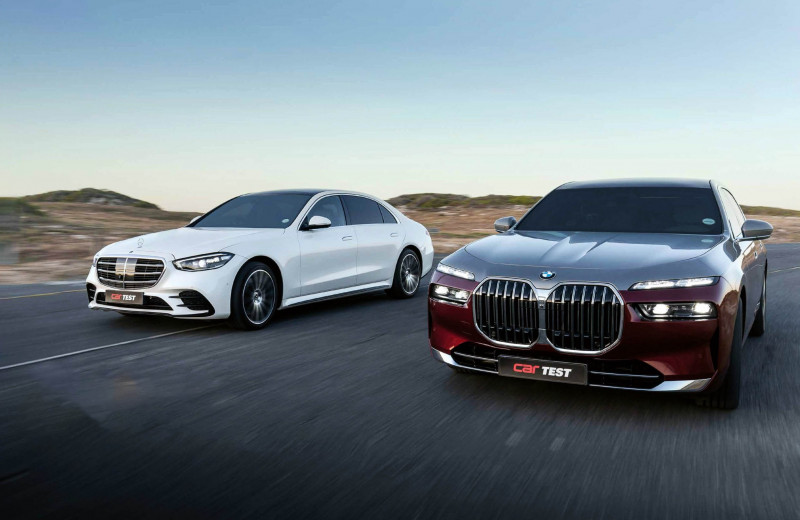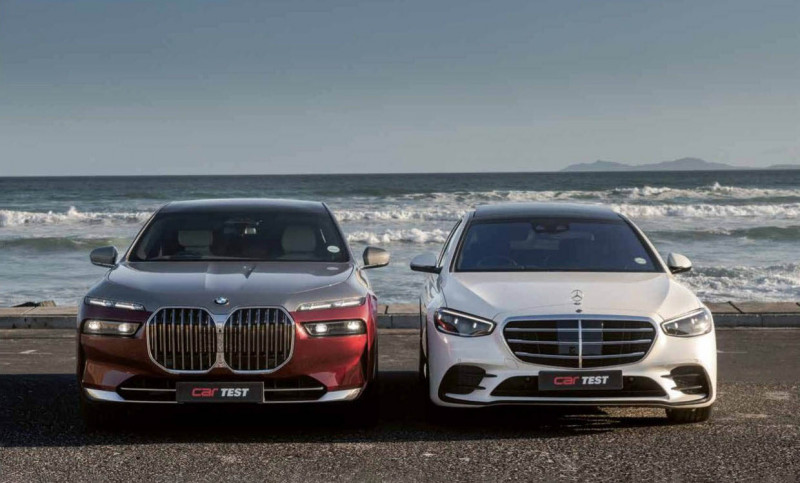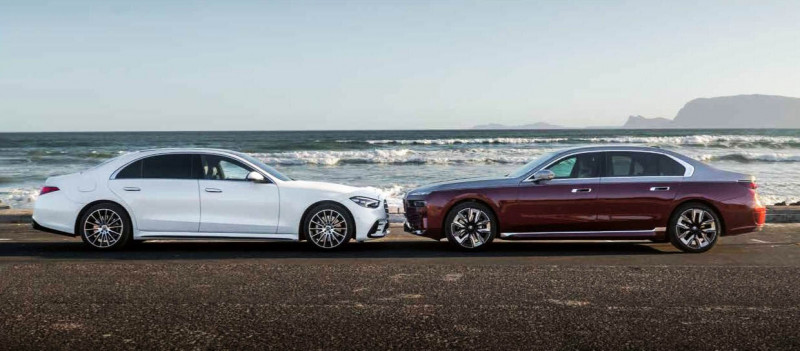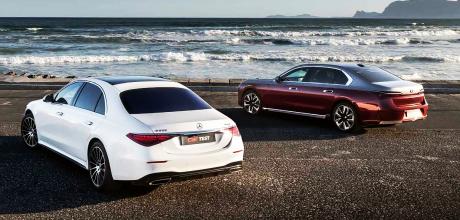2024 BMW 740i Design Pure Excellence G70 vs. 2023 Mercedes-Benz S500 L 4Matic V223
The new all new 2024 BMW 7 Series G70 takes on the 2023 Mercedes-Benz S-Class W223 for luxury sedan supremacy.
Elder Statesman G70 BMW 7 Series vs V223 Mercedes-Benz S-Class
When the S500 W223 was tested for the May issue last year, the CAR team felt that the decision to once again hand the segment crown back to Stuttgart’s range-topping sedan was more than justified, given how much Mercedes-Benz had improved on what we deem to be critical areas of evaluation, such as refinement, ride comfort and technology.

It just so happened that the S-Class had long been the title holder in that division before the previous-generation (G11/G12) BMW 7 Series made a strong argument for itself and snatched bragging rights. The victory would be short-lived however, when the current S-Class (W223) would give us reason enough to proclaim that it is once again the undisputed king. At least until the next new rival arrived at our offices for evaluation, that is.

FIRST IMPRESSIONS COUNT
The G70 is striking, but going so far as to call the new G70 7 Series/i7 a beautiful vehicle is a bit of a stretch. Whereas the S-Class’s elegance is by way of its rounded lines and sleeker headlamps and taillamps over its predecessor, the 7 screams out for your attention.
The comparison between the two was literally evident whenever we had the two cars out in traffic. Compounded by their respective paint finishes (the Mercedes-Benz finished in a rather simple pearl white versus the BMW’s optional two-tone paint job), the S500 blended into rush-hour traffic en route to a late-afternoon photo shoot, while the 740i had passers-by craning their necks for another glance or whipping out smartphones to capture the moment.

Parking the two nose-to-nose, side by side and in formation for the images you can see on these pages, it was easier for the team to appreciate just how much bigger than the S-Class the 7 Series is in the metal.
The S-Class’s rounded pillars and roofline don’t give away any width to the 7; in fact, the S500 is 5 mm wider. But the squarish, upright design of the BMW gives it the advantage in height and length, of 41 mm and 212 mm, respectively. Its wheelbase is also 109 mm longer than that of the Mercedes-Benz.
The S-Class’s exterior is quite restrained and makes use of relatively modest 20-inch wheels and thin strips of chromed metal that borders the side windows, caps the taillamps and makes up the outline of the grille. The application of chrome on the 740i is considerably more liberal in this specification, with large helpings on the dominant kidney grille and at the very bottom of the front bumper lip. Along its profile, the 7 features thicker bars of chrome around the side glass, the outlines around the door handles, and on the side skirts. While the S500 dual exhaust exits are chrome-tipped, the bottom of the 7’s rear bumper is outlined with more chrome as the exhaust tailpipes are neatly tucked underneath.
OPULENT CABINS
Sidle up next to the driver’s-side door of the S500 and the rectangular door handles pop out automatically for you to grab and pull. The doors open up to reveal a cabin swathed in stitched black leather with dark wood veneer.
The seats are broad, comfortable and evoke a sense of sitting down into a massive tub with all the toys laid out around you. The centre console, finished in piano gloss plastic, rises high enough for you to rest your arm on while driving; and the massive MBUX infotainment screen that lays at an angle up the facia falls easily to hand.
There’s a general sense of wellbeing for the four occupants of the S-Class’s interior, especially given the suite of items that heightens the sense of occasion like the ambient lighting through the seams of the trim, fragranced climate control and massage function from the seats.
Standing next to the BMW, you reach in through the chrome-bordered recesses in the doors, palm up, and tug. The automatic door swings open, and in stark opposition to the S500’s dark interior, the 740i supplied to CAR makes use of many different textures and materials. The cream-coloured leather contrast with the wood oak trim, and instead of the shinier trim in the S500, the BMW uses what the Bavarians call Crafted Clarity crystal glass to form the gear shifter, seat-adjustment knobs and iDrive controller.
Running through the middle of the facia is the BMW interaction bar that changes according to your ambient lighting preference and which driving mode the 7 Series is in. If the hazard lights are switched on, the bar flashes in bright red during the first few clicks just so that you know they’re on.
If you’ve ticked all the right options boxes and packages on the 740i, then you can drop the massive 31,3-inch theatre screen for the rear seat passengers, or those perched on the outer rear seats can do it themselves via the Touch Command displays that look like smaller smartphones in either door. Once the screen starts sliding into position, then the rear window blind automatically rises so as not to distract following motorists with the latest episodes of whatever those seated at the rear are watching.
Both models do allow for the rear-left passenger to recline their seat to a level that’s very leisurely; the front passenger seat back tilts forward while the base slides at the same time. The operation is slightly faster in the 7 series and the seat folds flatter.
The Mercedes also came with an optional fridge that is accessed between the two rear passengers. While handy for keeping a bottle of bubbly cold, it ate into the boot space significantly. Despite that, the S500’s boot is still only slightly smaller than the BMW’s, by just 8 litres. There is generally a sense of greater spaciousness in the 7 Series, particularly for the rear-seat passengers, that is afforded by the wheelbase advantage.
STACKING UP THE POWERTRAINS
We’ve previously mentioned that the nomenclature of German vehicle badges no longer denotes engine capacity or cylinder count, and both of these sedans are testament to that. Spotting both the S500 and 740i badges on their hindquarters used to mean that you could find large normally aspirated V8 engines nestled underneath their respective long bonnets, but for the past decade these have given way to turbocharged inline six-cylinder motors that both make 520 N.m of torque across flat torque bands that start as low as 1 800 N.m in the case of the S500 (the BMW makes that figure only 50 r/min higher). The S500 delivers that amount all the way to 5 500 r/min, whereas the 740i’s peak drops off after 5 000 r/min.
Both make use of automatic transmissions, but the primary difference is that the S500 sends its output to all four corners via Mercedes-Benz’s 4Matic all-wheel drive system, whereas the 740i only makes use of the rear axle. Both also use mild-hybrid electric architecture; in the case of the Mercedes, an integrated starter-generator provides 16 kW and 250 N.m of torque, and the BMW’s power unit is good for 13 kW and 200 N.m of torque.
ON THE ROAD
In our test last year, we were pleasantly surprised that despite the S500’s 2 232 kg heft, it was no slouch from zero to 100 km/h and registered an impressive 5,81 seconds against the benchmark sprint. Dispatching slow-moving traffic from 80–120 km/h took just 3,44 seconds. The 740i weighed in at a little bit less than the Merc, but the Bimmer, despite being down on power, managed to clock 100 km/h from rest in 5,17 seconds and managed the same overtaking manoeuvre in 3,34 seconds. The BMW also managed to drink significantly less fuel on our real-world fuel route, just a touch under 8,5 litres/100 km, compared with the S500’s 9,18 litres/100 km.
Where the Mercedes takes back some pride is in the way of on-road manners and general cruising competence thanks to its adaptive damping and air suspension, which remains excellent. The 740i is definitely not lacking, but the undercurrent of BMW’s sporting pretence has always had it lag behind slightly in ride comfort because they tend to be sprung a little stiffer. The fitment of lower-profile rubber on the rear axle doesn’t exactly help the situation, though the flip side of that is that the 740i feels way more agile than a sedan weighing in at well over two tonnes has a right to.
SUMMARY
While it cannot be denied that the 7 Series commands attention, be that positive or negative from both the approving nods and the frowning faces we witnessed while driving the 7, the general consensus among the team was that the more subtle style displayed by the S-Class is the preferred approach to luxury motoring. At initial glance, the price difference in the match-up cards seems to place the 7 Series at an advantage, but that’s the price for the base model Design Pure Excellence.
Much of the niceties we have written about, such as the crystal lights, automatic doors, 21-inch aerodynamic wheels, luxurious rear passenger seats, theatre screen, crystal seat switches and LED-lit panoramic glass roof are optional extras. In fact, if you spec the 740i to the level of the S500L, you’d be spending well in excess of R500 000 to match or exceed the S-Class, though we don’t for a moment think that prospective buyers would bat an eyelid at the prospect of half-a-bar’s worth of accessories.
That said, some of those niceties are also optional in the S500, as we mentioned in that previous test. If you want to be seen or have to entertain a family at the rear, or want to impress other MPs by using the remote to open the doors, then perhaps the BMW tickles your fancy. If you just want to blend in with traffic, but still take comfort in the absolute luxury of the S500, then the Benz is probably going to appeal to you.
These are both absolutely magnificent luxury vehicles, and it really just comes down to your own individual taste as to which German machine you choose.
We at CAR all agree the 7 Series, particularly in this 740i, has made up some significant ground to the S-Class in terms of technology and luxury, but it doesn’t match the Mercedes-Benz for overall class and refinement.
The elegant S-Class still commands the respect of the segment Damian Adams
You can’t take your eyes off the 7 Series, but it doesn’t appeal to everyone Kyle Kock
The ambient lighting is a dominant feature of the S500’s cabin, offering a host of colour options.
BMW’s Interaction Bar neatly hides the vents for the climate control.
Both rear passenger in the S500 get their own screen.
All three rear passengers in the 740i share the mammoth Theatre Screen.
Both models use a digital display for the instrumentation, but differ immensely in the execution.
Both models allow for the left rear passenger to fully recline their seat to a level that’s very leisurely
Parked side-by-side, its easy to determine that the 7 Series is the larger of the two. Crystal glass i-Drive, gear selector and volume kob are a unique touch for the 7-Series. BMW’s turbo-petrol six-cylinder-motor is 40 kW down, but matches the S500 for peak torque output.
Multispoke 20-inch wheels the most extravagant addition to the S500’s otherwise understated profile.
The BMW’s two-tone finish (optional) screams “look at me”, whereas the S500 blends in
effortlessly.
From the rear, the 740i appears to be significantly narrower than the S500, but it’s
only by a miniscule 4mm.
BMW’s crystal headlamps add a jewel-like sheen, but its two tiered design is more difficult to swallow versus the S500’s slim-head-lamp.
Both models use chrome to outline their grilles, but the BMW’s is backlit as well.
Nose-to-nose, it’s difficult to tell that the 740i is longer overall. 08 Intricate optional 21-inch wheels on the 740i.
ENGINE
Cylinders: six, inline, longitudinal
Fuel supply: electronic direct fuel injection, turbocharged, intercooled, petrol
Bore/stroke: 83,0/92,4 mm
Cubic capacity: 2 999 cm3
Compression ratio: 10,5 to 1
Valve gear: d-o-h-c, four valves per cylinder
ENGINE OUTPUT
Max power ISO: 320 kW
Power peak/Red line: 5 900-6 100/6250r/min
Max torque: 520 N.m
Torque peak: 1 800-5 500 r/min
TRANSMISSION Type: nine-speed automatic
1st gear/2nd gear: 5,35/3,24 to 1
3rd gear/4th gear: 2,25/1,64 to 1
5th gear/6th gear: 1,21/1,00 to 1
7th gear/8th gear: 0,87/0,72 to 1
Top gear: 0,60/0,00 to 1
Reverse gear: 4,80 to 1
Final drive: 2,82 to 1
Drive wheels: all
Driver aids: ESC (electronic stability control), hill start
BRAKES
Front: 390 mm ventilated discs
Rear: 365 mm ventilated discs
Hydraulics: ABS with EBD and EBA
WHEELS AND TYRES
Tyre make: Bridgestone Turanza
Tyre size(f:r): 255/40 R20;285/35 R20
Spare – type and location: none, mobility kit
STEERING
Type: rack and pinion, electric power assist
Lock to lock: 2,2 turns
Turning circle diameter: 12,2 m
SUSPENSION
Front: independent, double wishbone, air springs, anti-roll bar
Rear: independent, multilink, air springs, anti-roll bar
WARRANTY & SERVICE INTERVALS
2-year/unlimited km warranty
5-year/100 000 km maintenance plan
Services according to onboard computer
Airbags: front/side/curtain/knee Air-con: quad-zone climate
Audio system: radio/aux-in/USB/Bluetooth/voice control/Android Auto + Apple CarPlay
Cruise control: standard, adaptive Sat-nav: standard Park assist: standard, incl. camera
Windows: all-electric Trip computer: standard Driver seat adjust: electric, incl. height
Folding rear seat: no
Upholstery: leather Isofix anchorages: outer rear
Steering adjust: electric rake + reach Steering audio controls: standard
Tyre sensors: standard
Wipers auto-on: standard Headlamps auto-on: standard Head-up display: standard
TEST RESULTS
TOP SPEED
Manufacturer’s figure: 250 km/h
PERFORMANCE
FACTORS
Test conditions**: Ambient temp/barometric press: 30 °C/1 009 hPa Test car’s odometer: 6 218 km
*Prices as recommended by manufacturer
**All tests conducted at sea level
FEATURES
CHECKLIST
ACCELERATION (sec)
SPEEDO CALIBRATION (true speed)
Odometer error: 0,70% over
60 80 100 120
58 78 98 118
0-60 0-80 0-100 0-120 0-140
2,8 4,13 5,81 7,97 10,38
POWER SPECIFICATIONS & TORQUE ENGINE SPEED
OVERTAKING ACCELERATION (sec)
FUEL CONSUMPTION
Fuel tank: 65 litres
Est. tank range (fuel index): 669 km
Taxable CO2 rating: 192 g/km
Manufacturer’s figure
8,10
L/100 km
CAR fuel index
9,72
L/100 km
Fuel route
9,18
L/100 km
Oil filter: R298,30 Air filter: R884,50 Left headlamp: R55 628,40
Left rear tyre: R5 973,00 Windscreen: R35 192,00 Brake pads
(front set): R3 632,50 Camchain (incl. tensioner): R11 561,20
Total parts basket: R113 169,90
PARTS
PRICES*
BRAKING TEST
Best/worst stop: 2,75/3,21
Average of 10 stops/rating: 2,96/excellent
Average stopping distance: 39,85 m
10 stops from 100 km/h measured in seconds.
Width (excl.mirrors): 1 954mm Track front/rear: 1 655/1 683 mm Towrating (braked): 2 100 kg
Gross frontal area: 2,64 m2 Drag coefficient: 0,22 Seating: 4
Built in Germany
Power/mass: 143 W/kg Power/litre: 107 kW/litre
Torque/litre: 173 N.m/litre Cabin noise level at idle: 37 dB
Engine speed (at true 120 km/h in top gear): 1 568 r/min
OVERTAKING ACCELERATION (sec)
40-60
60-80
80-100
100-120
120-140
AT
1,18
1,34
1,76
2,10
2,48
ENGINE
Cylinders: six, inline, longitudinal
Fuel supply: electronic direct fuel injection, turbocharged, intercooled, petrol
Bore/stroke: 82,0/94,6 mm
Cubic capacity: 2 998 cm3
Compression ratio: 11,0 to 1
Valvegear: d-o-h-c, four valves per cylinder
ENGINE OUTPUT
Max power ISO: 280 kW
Power peak/Red line: 5 200-6 250 / 6 500 r/min
Max torque: 520 N.m
Torque peak: 1 850-5 000 r/min
TRANSMISSION
Type: eight-speed automatic
1st gear/2nd gear: 5,25/3,36 to 1
3rd gear/4th gear: 2,17/1,72 to 1
5th gear/6th gear: 1,32/1,00 to 1
7th gear/Top gear: 0,83/0,64 to 1
Reverse gear: 3,71 to 1
Final drive: 3,08 to 1
Drive wheels: rear
Driver aids: ESC (electronic stability control), hill start
BRAKES
Front: 348 mm ventilated discs
Rear: 332 mm ventilated discs
Hydraulics: ABS with EBD and EBA
WHEELS AND TYRES
Tyre make: Pirelli P Zero
Tyre size(f:r): 255/40 R21;285/35 R21
Spare – type and location: none, mobility kit
STEERING
Type: rack and pinion, electric power assist
Lock to lock: 2,2 turns
Turning circle diameter: 12,2 m
SUSPENSION
Front: independent, MacPherson struts, air springs, anti-roll bar
Rear: independent, multilink, air springs, anti-roll bar
WARRANTY & SERVICE INTERVALS
2-year/unlimited km warranty
5-year/100 000 km maintenance plan
Services according to onboard computer
Airbags: front/side/curtain Air-con: quad-zone climate
Audio system: radio/aux-in/USB/Bluetooth/voice control/Apple CarPlay/Android Auto
Cruise control: standard, adaptive
Sat-nav: standard Park assist: standard, incl. camera
Windows: all-electric Trip computer: standard
Driver seat adjust: electric, incl. height
Folding rear seat: no
Upholstery: leather Isofix anchorages: outer rear
Steering adjust: electric rake + reach
Steering audio controls: standard
Tyre sensors: standard
Wipers auto-on: standard
Headlamps auto-on: standard
Head-up display: optional
TEST RESULTS
TOP SPEED
Manufacturer’s figure: 250 km/h
PERFORMANCE
FACTORS
Test conditions**: Ambient temp/barometric press: 18 ÅãC/1 021 hPa Test car’s odometer: 5 100 km
FEATURES
CHECKLIST
ACCELERATION (sec)
SPEEDO CALIBRATION (true speed)
Odometer error: 0,11% over
60 80 100 120
59 78 97 116
0-60 0-80 0-100 0-120 0-140
2,51 3,69 5,17 7,04 9,38
OVERTAKING ACCELERATION (sec)
FUEL CONSUMPTION
Fuel tank: 74 litres
Est. tank range (fuel index): 781 km
Taxable CO2 rating: 179 g/km
Manufacturer’s figure
7,90
L/100 km
CAR fuel index
9,48
L/100 km
Fuel route
8,50
L/100 km
Oil filter: R325,45 Air filter: R566,95 Left headlamp: R65 873,10
Left rear tyre: R8 099,00 Windscreen: R14 971,15 Brake pads
(front set): R1 881,40 Camchain (incl. tensioner): R3 578,15
Total parts basket: R95 295,20
PARTS
PRICES*
BRAKING TEST
Best/worst stop: 2,66/3,6
Average of 10 stops/rating: 2,90/excellent
Average stopping distance: 38,32 m
10 stops from 100 km/h measured in seconds.
Power/mass: 128 W/kg Power/litre: 93 kW/litre
Torque/litre: 173 N.m/litre Cabin noise level at idle: 00 dB
Engine speed (at true 120 km/h in top gear): 1 764 r/min
40-60
60-80
80-100
100-120
120-140
AT
0,99
1,20
1,48
1,86
2,30
Built
Headroom: 1 050/850 mm Headroom/kneeroom: 960/866 mm
*Prices as recommended by manufacturer
**All tests conducted at sea level
Width (excl.mirrors): 1 950mm Track front/rear: 1 663/1 683 mm Towrating (braked): 2 100 kg
Gross frontal area: 2,92 m. Drag coefficient: 0,26 Seating: 5
Headroom: 1 050/850 mm Headroom/kneeroom: 960/866 mm


